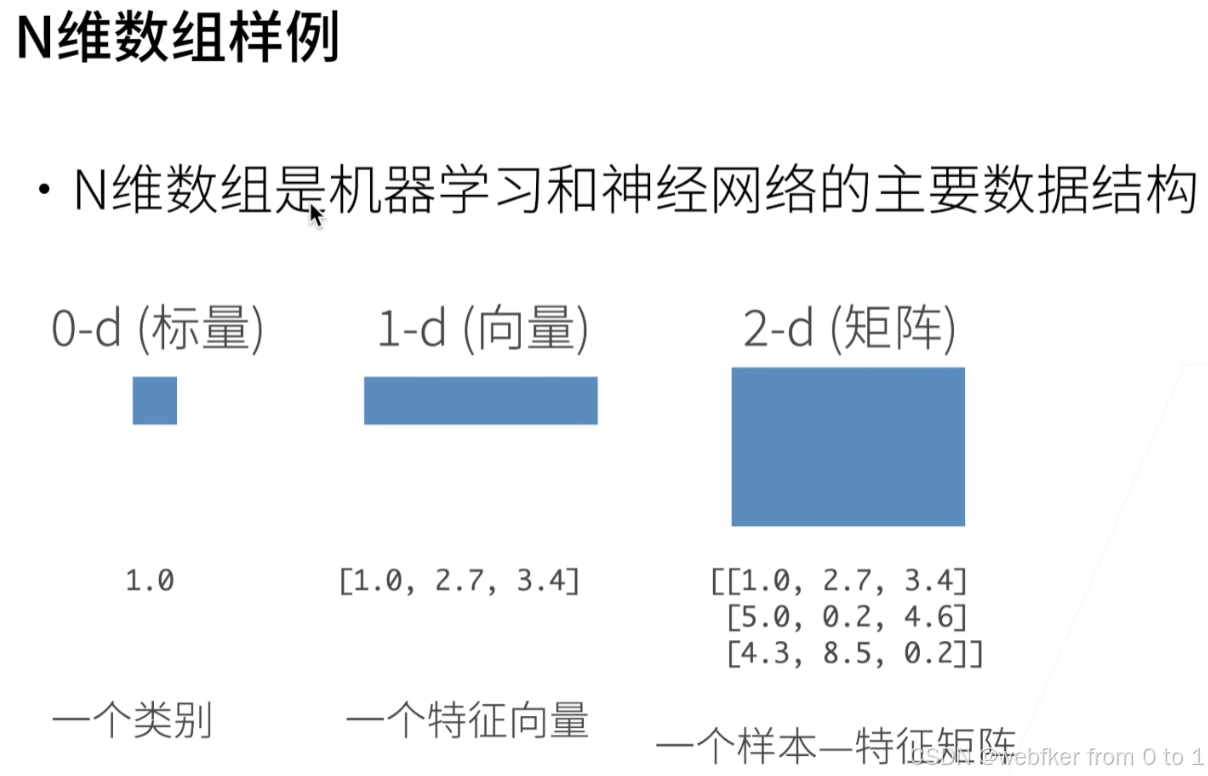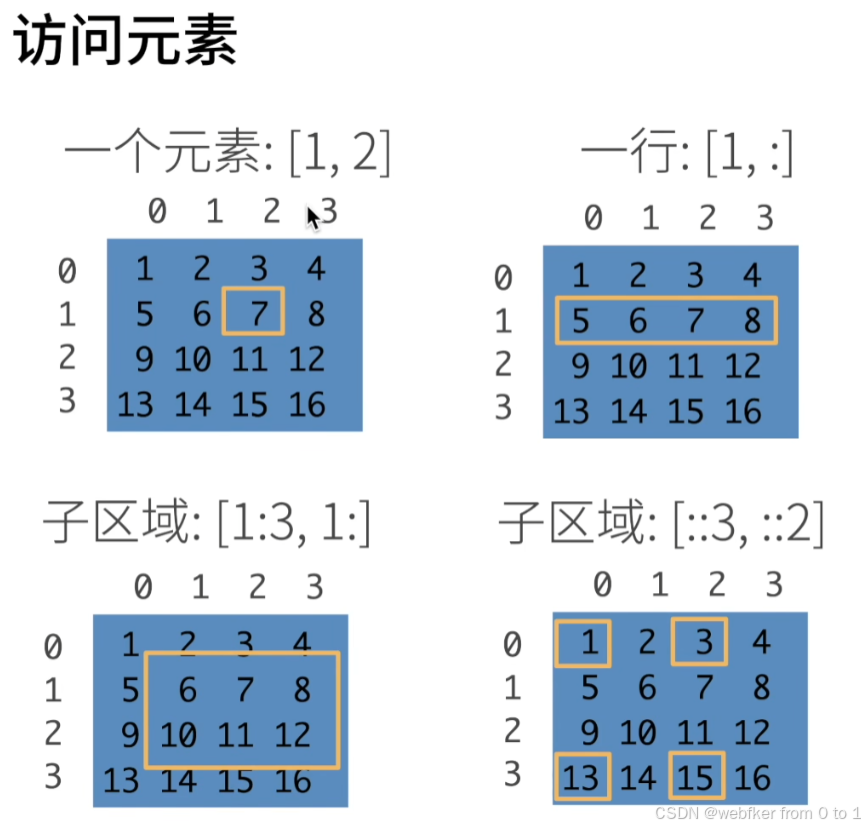阅读量:0
数据操作
数据操作
在实现数据操作之前需要了解一些定义:
张量:张量表示一个由数值组成的数组,这个数组可能有多个维度。
0-d(0维数组)为标量
1-d(1维数组)为向量
2-d(2维数组)为矩阵
……

创建数组

要创建一个向量:
x = torch.arange(12) print(x) 结果:
tensor([ 0, 1, 2, 3, 4, 5, 6, 7, 8, 9, 10, 11]) 通过shape属性来访问张量的形状和其中元素的总数:
print(x.shape) print(x.numel()) 结果:
torch.Size([12]) 12 要想改变一个张量的形状而不改变元素数量和元素值,可以调用reshape函数,可以看到他变成了一个三行四列的张量:
X = x.reshape(3, 4) print(X) 结果:
tensor([[ 0, 1, 2, 3], [ 4, 5, 6, 7], [ 8, 9, 10, 11]]) 使用全0、全1、其他常量,或者从特定分布中随机采样的数字:
print(torch.zeros(2, 3, 4)) print(torch.ones(2, 3, 4)) 结果:
tensor([[[0., 0., 0., 0.], [0., 0., 0., 0.], [0., 0., 0., 0.]], [[0., 0., 0., 0.], [0., 0., 0., 0.], [0., 0., 0., 0.]]]) tensor([[[1., 1., 1., 1.], [1., 1., 1., 1.], [1., 1., 1., 1.]], [[1., 1., 1., 1.], [1., 1., 1., 1.], [1., 1., 1., 1.]]]) 通过提供包含数值的Python列表(或嵌套列表),来为所需张量中的每个元素赋予确定值。
print(torch.tensor([[[2, 1, 4, 3], [1, 2, 3, 4], [4, 3, 2, 1]]]).shape) 结果:
torch.Size([1, 3, 4]) 常见的标准算术运算符(+、-、*、/和**)都可以被升级为按元素运算。
x = torch.tensor([1.0, 2, 4, 8]) y = torch.tensor([2, 2, 2, 2]) print(x + y, x - y, x * y, x / y, x ** y) 结果:
tensor([ 3., 4., 6., 10.]) tensor([-1., 0., 2., 6.]) tensor([ 2., 4., 8., 16.]) tensor([0.5000, 1.0000, 2.0000, 4.0000]) tensor([ 1., 4., 16., 64.]) 我们也可以把多个张量连结(concatenate)在一起 dim=0代表按行合并,dim=1代表按列合并,以此类推:
X = torch.arange(12,dtype=torch.float32).reshape((3, 4)) Y = torch.tensor([[2.0, 1, 4, 3], [1, 2, 3, 4], [4, 3, 2, 1]]) print(torch.cat((X, Y), dim=0)) print(torch.cat((X, Y), dim=1)) 结果:
tensor([[ 0., 1., 2., 3.], [ 4., 5., 6., 7.], [ 8., 9., 10., 11.], [ 2., 1., 4., 3.], [ 1., 2., 3., 4.], [ 4., 3., 2., 1.]]) tensor([[ 0., 1., 2., 3., 2., 1., 4., 3.], [ 4., 5., 6., 7., 1., 2., 3., 4.], [ 8., 9., 10., 11., 4., 3., 2., 1.]]) 可以通过比较,看两个张量中相同的部分
print(X == Y) 结果:
tensor([[False, True, False, True], [False, False, False, False], [False, False, False, False]]) 可以计算所有的向量
print(X.sum())
结果:
tensor(66.)
访问元素

赋值
X[1, 2] = 9 print(X) X[0:2, :] = 12 print(X) 结果:
tensor([[ 0., 1., 2., 3.], [ 4., 5., 9., 7.], [ 8., 9., 10., 11.]]) tensor([[12., 12., 12., 12.], [12., 12., 12., 12.], [ 8., 9., 10., 11.]]) 在维度相同但形状不同的情况下,即使形状不同,我们仍然可以通过调用 广播机制(broadcasting mechanism)来执行按元素操作,该机制通过适当复制元素来扩展一个或两个数组,以便在转换之后,两个张量具有相同的形状之后再对生成的数组执行按元素操作。
a = torch.arange(3).reshape((3, 1)) b = torch.arange(2).reshape((1, 2)) print(a) print(b) # 由于a和b分别是3*1和1*2矩阵,如果让它们相加,它们的形状不匹配。 # 矩阵广播机制将会将其化为一个更大的3*2矩阵,如下所示:矩阵a将复制列,矩阵b将复制行,然后再按元素相加。 print(a + b) 结果:
tensor([[0], [1], [2]]) tensor([[0, 1]]) tensor([[0, 1], [1, 2], [2, 3]]) 单数赋值
使X的第2行第3列变为9
X[1, 2] = 9 print(X) 结果:
tensor([[ 0., 1., 2., 3.], [ 4., 5., 9., 7.], [ 8., 9., 10., 11.]]) 按区域赋值
让矩阵的前两行和所有列的值都改为12:
X[0:2, :] = 12 print(X) 结果:
tensor([[12., 12., 12., 12.], [12., 12., 12., 12.], [ 8., 9., 10., 11.]]) 张量转换为NumPy张量
A = X.numpy() B = torch.tensor(A) print(type(A)) print(type(B)) 结果:
<class 'numpy.ndarray'> <class 'torch.Tensor'> 将大小为1的张量转换为标量
a = torch.tensor([3.5]) print(a,a.item,float(a),int(a)) 结果:
tensor([3.5000]) 3.5 3.5 3 